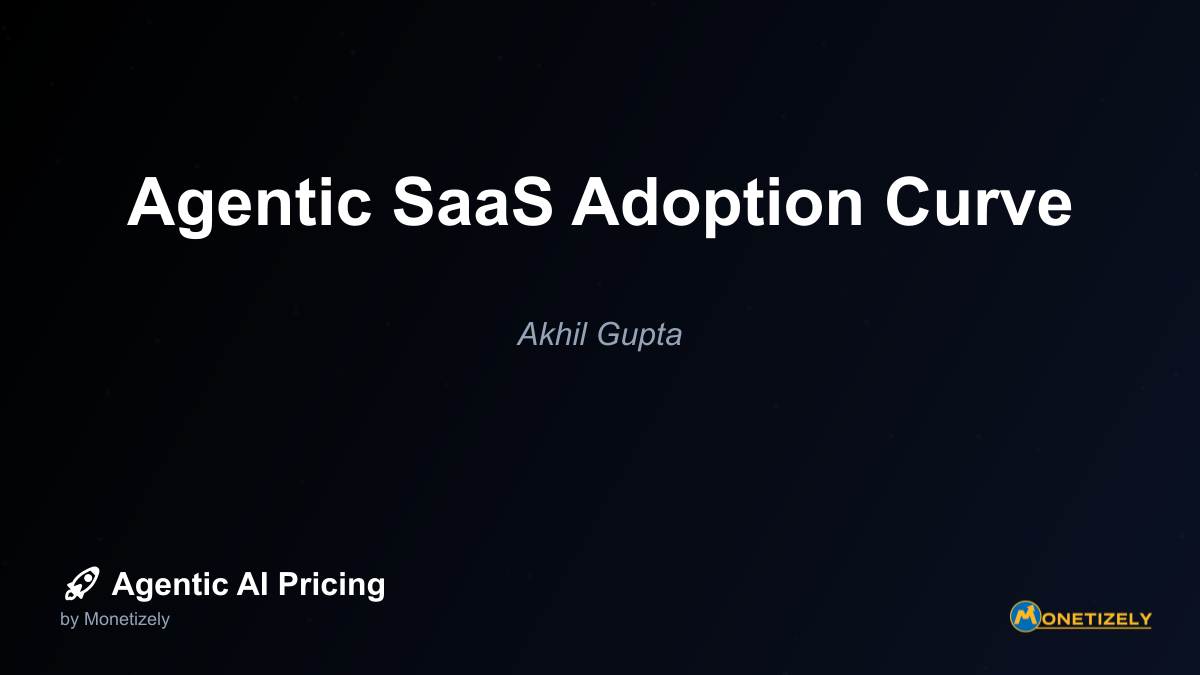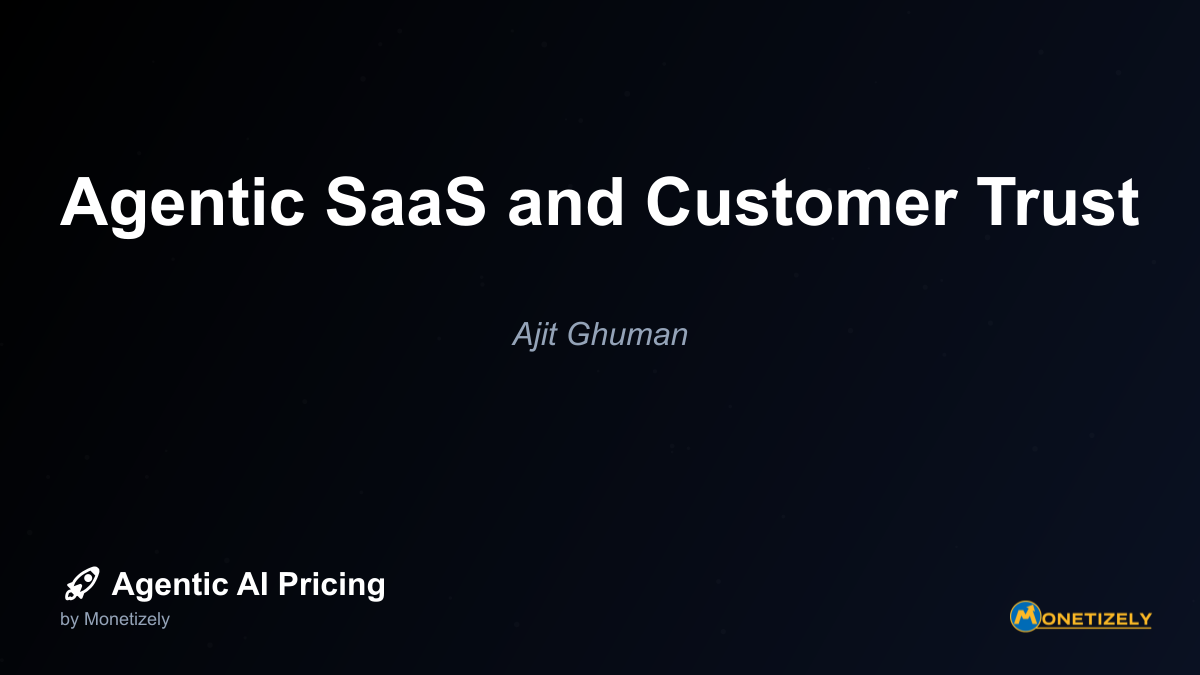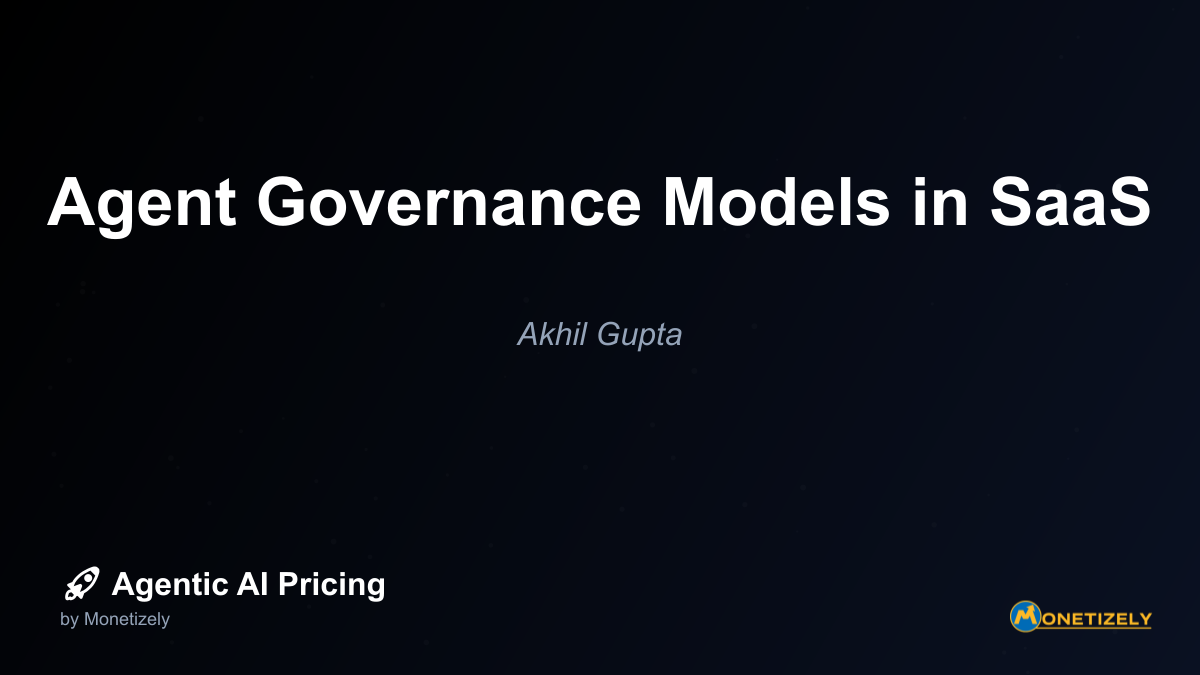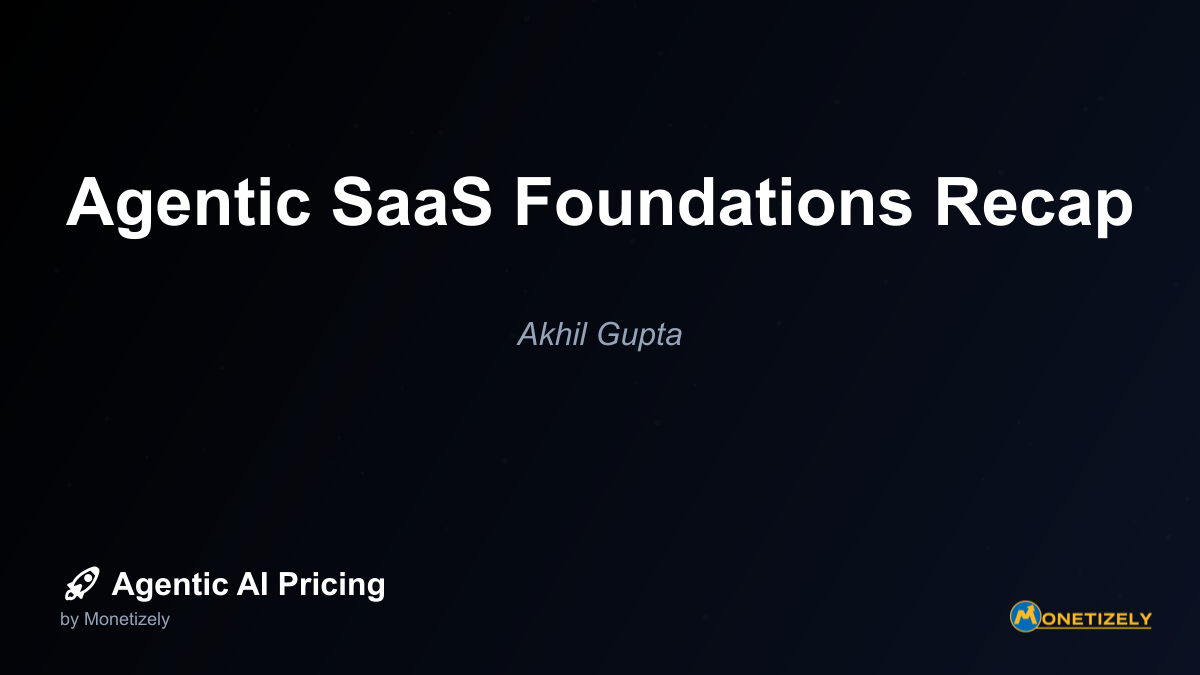· Ajit Ghuman · Agentic SaaS Fundamentals · 11 min read
Trust & Transparency in Agentic SaaS
AI and SaaS Pricing Masterclass
Learn the art of strategic pricing directly from industry experts. Our comprehensive course provides frameworks and methodologies for optimizing your pricing strategy in the evolving AI landscape. Earn a professional certification that can be imported directly to your LinkedIn profile.

The Transparency Imperative in Agentic SaaS
Transparency in agentic systems goes beyond simple explanations of how the technology works. It encompasses three critical dimensions that must be addressed cohesively:
1. Decision-Making Visibility
Users need to understand not just what decisions are being made but how and why they’re being made. This involves exposing the logic, data sources, and reasoning processes that drive autonomous actions.
Unlike traditional software that executes explicit commands, agentic systems make judgment calls based on complex criteria. Providing visibility into this decision-making process is essential for building trust.
For example, when an agentic sales assistant prioritizes certain leads over others, users should be able to access a clear explanation of the factors that influenced this prioritization—whether it was based on historical conversion rates, engagement metrics, or other data points.
2. Outcome Predictability
Users need reasonable expectations about what the system will do in various scenarios. This predictability creates a foundation of trust by reducing uncertainty about how the system will behave.
Effective agentic SaaS platforms provide clear guardrails and boundaries within which the system operates. This might include:
- Explicitly stating what actions the system can and cannot take
- Defining thresholds for when human approval is required
- Outlining the range of possible outcomes in different scenarios
When users can anticipate system behavior with reasonable accuracy, they’re more likely to delegate meaningful responsibilities to it.
3. Value Alignment
Perhaps most importantly, users need confidence that the system’s objectives align with their own. This means making explicit the optimization targets and values that guide the system’s behavior.
Value alignment issues occur when an agentic system pursues goals that conflict with user priorities. For instance, if a content creation agent optimizes for engagement metrics while sacrificing brand voice consistency, users will quickly lose trust despite technical competence.
Transparent value alignment involves clearly articulating:
- What the system is optimizing for
- How it balances competing priorities
- Where human values and judgment are encoded in the system
The Business Case for Transparency
While the ethical case for transparency is compelling, there’s also a strong business rationale. Companies that prioritize transparency in their agentic systems enjoy several competitive advantages:
Accelerated Adoption
Research by Gartner indicates that organizations with transparent AI systems achieve 50% faster user adoption compared to those with “black box” approaches. This adoption acceleration stems from reduced uncertainty and risk perception among potential users.
Comparative studies of agentic versus traditional AI adoption show that transparency concerns become exponentially more important as systems gain greater autonomy. When users understand how and why decisions are made, they’re more willing to entrust meaningful responsibilities to autonomous systems.
Higher Perceived Value
Transparency directly impacts willingness to pay. McKinsey research found that enterprise customers are willing to pay a 15-25% premium for AI systems that provide clear explanations for their decisions compared to functionally equivalent “black box” alternatives.
This value perception is particularly pronounced in high-stakes domains like healthcare, finance, and legal services, where decisions have significant consequences and accountability is essential.
Reduced Support Costs
Transparent systems generate fewer support tickets and escalations. When users understand why a system took a particular action, they’re less likely to question or contest the outcome. This understanding reduces the “intervention burden” where humans must constantly monitor and override autonomous decisions.
According to IBM research, organizations implementing transparent AI systems report a 30-40% reduction in human oversight requirements compared to opaque systems with similar capabilities.
Enhanced Regulatory Compliance
As regulatory frameworks for AI accountability develop globally, transparency is becoming a legal requirement in many jurisdictions. The EU’s AI Act, for example, mandates explanations for high-risk AI systems, while similar requirements are emerging in the US, Canada, and Asia.
By building transparency from the ground up, companies can future-proof their agentic SaaS offerings against evolving regulatory requirements, avoiding costly retrofits or market restrictions.
Practical Approaches to Building Transparency
Implementing transparency in agentic systems requires deliberate design choices across the product development lifecycle. Here are key strategies that successful agentic SaaS providers are employing:
Explainable Architecture
The foundation of transparency begins with system architecture. While complex neural networks power many AI capabilities, successful agentic systems often employ hybrid approaches that combine:
- Neural components for perception and pattern recognition
- Symbolic components for reasoning and decision-making
- Explicit rule systems for guardrails and constraints
This architectural approach creates natural points for explanation and transparency. For example, an agentic document processing system might use neural networks for text classification but explicit rules for determining which documents require human review.
Decision Logging and Audit Trails
Comprehensive logging of system decisions and their rationale provides the raw material for transparency. Effective audit trails should capture:
- The specific inputs considered in each decision
- The alternatives that were evaluated
- The criteria used for selection
- Any uncertainty or confidence metrics
These logs serve both immediate explanatory purposes and enable retrospective analysis of system behavior patterns over time.
Confidence Metrics and Uncertainty Indicators
Transparent agentic systems communicate not just what they know, but what they don’t know. By explicitly representing uncertainty, these systems build trust by avoiding false certainty.
Practical implementations include:
- Confidence scores accompanying recommendations
- Explicit flagging of edge cases or unusual scenarios
- Clear indications when the system is operating outside its training distribution
Users trust systems more when they acknowledge their limitations rather than projecting unfounded certainty.
Progressive Disclosure of Complexity
Transparency doesn’t mean overwhelming users with technical details. Effective systems employ progressive disclosure, providing simple explanations by default with the option to explore deeper levels of detail.
This might take the form of:
- Summary explanations for routine decisions
- Detailed justifications available on demand
- Technical diagnostics for expert users or auditors
This layered approach ensures transparency is accessible to different user types without creating information overload.
Human-in-the-Loop Integration Points
Strategic integration of human oversight creates natural transparency checkpoints. Well-designed agentic systems include:
- Clear approval workflows for consequential decisions
- Intuitive override mechanisms
- Feedback loops that improve system performance
These integration points not only enhance transparency but also provide opportunities for the system to learn from human expertise.
Balancing Transparency with Other Priorities
While transparency is essential, it must be balanced with other important considerations in agentic SaaS design:
Performance vs. Explainability
There’s often a tension between model performance and explainability. The most accurate AI systems are frequently the least explainable, creating a challenging tradeoff.
Successful agentic SaaS companies address this by:
- Using simpler, more explainable models for high-stakes decisions
- Reserving complex “black box” approaches for low-risk scenarios
- Creating surrogate models that approximate complex systems in explainable ways
The key is matching the level of explainability to the importance of the decision being made.
Intellectual Property Protection
Complete transparency might expose proprietary algorithms or training data. Companies must balance openness with protecting their competitive advantages.
Effective approaches include:
- Focusing transparency on decision rationales rather than underlying algorithms
- Using explanation techniques that don’t require exposing model internals
- Creating abstracted explanations that communicate essential information without revealing trade secrets
This balanced approach satisfies user transparency needs while preserving IP protection.
User Experience Simplicity
Too much information can overwhelm users and degrade the user experience. Transparency must be implemented in ways that enhance rather than detract from usability.
Best practices include:
- Embedding explanations contextually within workflows
- Using visual representations to simplify complex decisions
- Providing explanations that match user mental models
When done well, transparency becomes a natural extension of the user experience rather than a separate “explanation layer.”
Trust-Building Through Pricing Transparency
Interestingly, pricing models themselves can either enhance or undermine trust in agentic systems. Transparent pricing that aligns with value creation reinforces the overall trustworthiness of the platform.
Value-Aligned Pricing Models
Pricing structures that clearly connect to delivered value demonstrate alignment between vendor and customer interests. For agentic systems, this might include:
- Outcome-based pricing tied to measurable results
- Performance guarantees with financial consequences
- Risk-sharing models for uncertain applications
These approaches signal confidence in the system’s capabilities while creating accountability for results.
Predictable Cost Structures
Unpredictable costs create anxiety that undermines trust. This is particularly true for agentic systems where usage patterns may be difficult to forecast as the system operates autonomously.
Effective approaches include:
- Usage caps with clear overage policies
- Simulation tools to estimate costs under different scenarios
- Granular usage analytics that connect activity to value
When users can confidently predict costs, they’re more likely to expand usage of agentic capabilities.
Transparent Pricing Communication
How pricing is communicated impacts trust as much as the pricing model itself. Clear, straightforward pricing information without hidden fees or complex calculations reinforces the transparency of the overall system.
Best practices include:
- Plain-language pricing documentation
- Interactive calculators that show cost implications
- Proactive notifications about approaching usage thresholds
This transparency in pricing mirrors and reinforces transparency in the system’s decision-making.
Case Studies in Agentic Transparency
Let’s examine how leading companies are implementing transparency in their agentic SaaS offerings:
Salesforce Einstein GPT
Salesforce’s agentic AI assistant for CRM demonstrates several transparency best practices:
- Decision Cards: Each recommendation includes a “Why?” button that reveals the data points and reasoning behind the suggestion.
- Confidence Indicators: Recommendations display confidence levels using both visual cues and percentage scores.
- Influence Trackers: Users can see which specific customer interactions or data points most influenced a particular recommendation.
- Override Tracking: The system records when users accept or reject recommendations, creating a feedback loop that improves future suggestions.
This transparency approach has resulted in adoption rates 35% higher than previous AI features that lacked these explanation capabilities.
GitHub Copilot
GitHub’s agentic coding assistant balances powerful capabilities with transparency:
- Source Attribution: When suggestions draw heavily from specific repositories, Copilot identifies these sources.
- Alternative Suggestions: Users can view multiple alternatives rather than a single “black box” recommendation.
- Confidence Highlighting: Color-coding indicates parts of suggestions where the model has higher or lower confidence.
- Integration with Documentation: Suggestions link to relevant documentation, connecting recommendations to established best practices.
These transparency features have been crucial in building trust among developers, a user group that is typically highly skeptical of automated solutions.
Notion AI
Notion’s agentic writing assistant demonstrates how to implement transparency in content creation:
- Draft Versioning: The system maintains multiple versions, allowing users to compare different approaches.
- Source Linking: When drawing information from specific sources, the system provides citations and links.
- Style Explanations: The system explains stylistic choices in terms of readability, tone, and audience appropriateness.
- Uncertainty Flagging: When making factual claims with low confidence, the system explicitly flags these for user verification.
These transparency features have helped Notion AI achieve unusually high retention rates compared to other AI writing assistants.
Implementation Roadmap for Agentic Transparency
For companies developing agentic SaaS products, implementing transparency should follow a strategic progression:
Phase 1: Foundation Building
Start with fundamental transparency capabilities:
- Comprehensive logging of all system actions and decisions
- Basic explanation capabilities for the most important decisions
- Clear documentation of system capabilities and limitations
- Simple feedback mechanisms for users to report unexpected behavior
These foundational elements establish the infrastructure for more sophisticated transparency features.
Phase 2: Enhanced Explanations
Build on the foundation with richer explanation capabilities:
- Contextual explanations that adapt to user expertise levels
- Visual representations of decision processes
- Comparative explanations that show alternatives considered
- Integration of explanations into normal workflows
These enhancements make transparency more accessible and useful to different user types.
Phase 3: Proactive Transparency
Move from reactive to proactive transparency:
- Anticipatory explanations that precede important actions
- Anomaly detection that highlights unusual system behavior
- Personalized transparency based on individual user preferences
- Transparency APIs that allow integration with governance systems
This proactive approach shifts transparency from a feature to a core aspect of the user experience.
Phase 4: Collaborative Transparency
Establish transparency as a collaborative process:
- User-guided exploration of system reasoning
- Community-based evaluation of system explanations
- Transparency benchmarking against industry standards
- Continuous improvement based on transparency metrics
This mature approach treats transparency as an ongoing dialogue between system and users rather than a static feature.
Measuring Transparency Effectiveness
To ensure transparency efforts are achieving their goals, companies should implement specific metrics:
Trust Indicators
- User confidence ratings in system decisions
- Override frequency (lower indicates higher trust)
- Delegation levels (what responsibilities users entrust to the system)
- Feature adoption rates for autonomous capabilities
These metrics track whether transparency is building the trust necessary for meaningful adoption.
Comprehension Metrics
- Explanation satisfaction scores
- Time spent reviewing system explanations
- User ability to predict system behavior in new scenarios
- Accuracy of user mental models about system capabilities
These metrics assess whether users truly understand system behavior rather than just receiving explanations.
Business Impact Measures
- Support ticket volume related to unexpected system behavior
- Time-to-value for new users
- Expansion rates for existing customers
- Competitive win rates against less transparent alternatives
These metrics connect transparency efforts to tangible business outcomes.
Conclusion: The Transparent Future of Agentic SaaS
As agentic SaaS continues to evolve, transparency will become a defining competitive differentiator. Organizations that master the art of making autonomous systems understandable, predictable, and aligned with user values will enjoy faster adoption, higher perceived value, and stronger customer loyalty.
The most successful agentic SaaS products will treat transparency not as a compliance checkbox or technical feature, but as a fundamental design principle that shapes every aspect of the user experience. By helping users understand what these systems are doing, why they’re doing it, and how it aligns with user goals, companies can bridge the trust gap that currently limits the potential of autonomous software.
For SaaS executives and product leaders, the message is clear: invest in transparency capabilities as a core part of your agentic AI strategy. The companies that build trust through transparency today will lead the agentic revolution tomorrow.
Co-Founder & CEO
Ajit is the author of Price To Scale, a top book on SaaS Pricing and is the Founder of Monetizely. Ajit has led and worked in pricing and product marketing at firms like Twilio, Narvar and Medallia. His work has been featured in Forbes and VentureBeat. Ajit regularly consults with software companies from Seed stage to post-IPO on pricing strategy. Ajit is also a highly-rated co-instructor for 'The Art of SaaS Pricing and Monetization' on Maven.
Pricing Strategy Audit
Let our experts analyze your current pricing strategy and identify opportunities for improvement. Our data-driven assessment will help you unlock untapped revenue potential and optimize your AI pricing approach.




